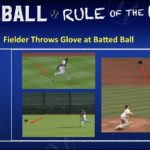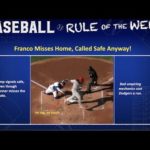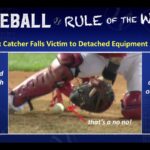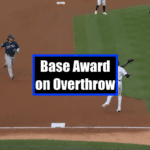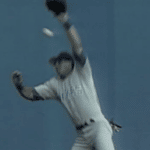5.06 (c) Dead Balls
The ball becomes dead and runners advance one base, or return to their bases, without liability to be put out, when:
(1) A pitched ball touches a batter, or his clothing, while in his legal batting position; runners, if forced, advance;
(2) The plate umpire interferes with the catcher’s throw attempting to prevent a stolen base or retire a runner on a pick-off play; runners may not advance.
NOTE: The interference shall be disregarded if the catcher’s throw retires the runner.
While the ball is dead no player may be put out, no bases may be run and no runs may be scored, except that runners may advance one or more bases as the result of acts which occurred while the ball was alive (such as, but not limited to a balk, an overthrow, interference, or a home run or other fair ball hit out of the playing field).
Rule 5.06(c)(2) Comment (Rule 5.09(b) Comment):
Umpire interference may also occur when an umpire interferes with a catcher returning the ball to the pitcher.
A balk is committed; runners advance; (See Penalty 6.02(a) (Penalty 8.05).)
A ball is illegally batted; runners return; 31
(5) A foul ball is not caught, in which case runners return to their bases. The umpire-in-chief shall not put the ball in play until all runners have retouched their bases;
(6) A fair ball touches a runner or an umpire on fair territory before it touches an infielder including the pitcher, or touches an umpire before it has passed an infielder other than the pitcher; runners advance, if forced.
If a fair ball goes through, or by, an infielder, no other infielder has a chance to make a play on the ball and the ball touches a runner immediately behind the infielder that the ball went through, or by, the ball is in play and the umpire shall not declare the runner out. If a fair ball touches a runner after being deflected by an infielder, the ball is in play and the umpire shall not declare the runner out;
Rule 5.06(c)(6) Comment (Rule 5.09(f) Comment):
If a fair ball touches an umpire working in the infield after it has bounded past, or over, the pitcher, it is a dead ball. If a batted ball is deflected by a fielder in fair territory and hits a runner or an umpire while still in flight and then caught by an infielder it shall not be a catch, but the ball shall remain in play.
(7) A pitched ball lodges in the umpire’s or catcher’s mask or paraphernalia, and remains out of play, runners advance one base;
Rule 5.06(c)(7) Comment (Rule 5.09(g) Comment):
If a foul tip hits the umpire and is caught by a fielder on the rebound, the ball is “dead” and the batsman cannot be called out. The same shall apply where such foul tip lodges in the umpire’s mask or other paraphernalia.
If a third strike (not a foul tip) passes the catcher and hits an umpire, the ball is in play. If such ball rebounds and is caught by a fielder before it touches the ground, the batsman is not out on such a catch, but the ball remains in play and the batsman may be retired at first base, or touched with the ball for the out.
If a pitched ball lodges in the umpire’s or catcher’s mask or paraphernalia, and remains out of play, on the third strike or fourth ball, then the batter is entitled to first base and all runners advance one base. If the count on the batter is less than three balls, runners advance one base.
If a ball is intentionally placed inside a player’s uniform (e.g., a pants pocket) for the purpose of deceiving a base runner, the umpire shall call “Time.” The umpire will place all runners at least one base (or more if warranted, in the umpire’s judgment, in order to nullify the action of the ball being put out of play), from the base they originally occupied.
(8) Any legal pitch touches a runner trying to score; runners advance.



